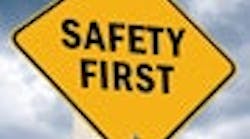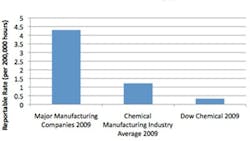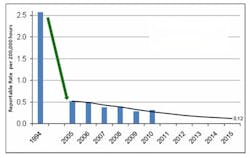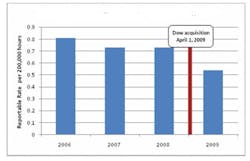Companies that want to elevate their environment, health and safety (EH&S) performance should focus on two sides of safety: the soft side and the hard side. The soft side is all about making EH&S a part of your culture and your DNA. The hard side is the engine that drives that culture, such as companywide operating disciplines, processes and tools.
Both are critical, but the soft side is more difficult to achieve because it involves human behavior. It takes time to nurture a safety mindset and make it a way of life rather than a box to check or something to do as time allows. Eventually, the effort pays off as safety behaviors become automatic, like putting on a seatbelt, and that’s when you start to see dramatic improvements.
You can buy most of the processes and tools to implement and measure safety programs from organizations like the National Safety Council and the American Chemistry Council and from various consulting companies. However, you can’t buy a safety culture; it must happen from the inside out.
Dow has created a safety culture — testifying to our success, we currently hold the Robert W. Campbell Award of the National Safety Council, which recognizes achievement in integrating EH&S into business success. We do things differently than other companies in the process industries — but our approach certainly is transferable.
FIVE TIPS
In my experience, when companies fail in their safety performance, it’s because they didn’t focus enough on the behaviors — when that link is broken, problems occur. For this reason, I’d like to share five tips to help you create an enduring safety culture, one in which safety becomes second nature.
1. Make safety the top priority… Have the philosophical discussion. Every company should ask itself what it’s doing to create the right behaviors to keep people and the environment safe. Early in its history, Dow chose to create a culture predicated on caring for human health, the environment, our communities and the world — and making that a top priority in terms of time, attention and money. From there, our goals and operating disciplines fell into place and have continued to advance with knowledge and technology. It’s one reason why working at Dow is 19 times safer than working in a grocery store and 23 times safer than working in a hospital.
Putting safety first is critical but conversations can’t be only about the numbers; they must put concern for the individual and the enterprise’s future first. When you do that, you’re building a culture in which tolerance for harm and injury is very low and safety expectations are very high. Employees at all levels will start demanding the processes and tools, and get inspired to make a difference. When that happens, safety becomes a part of your DNA. Improved behaviors will fuel innovative thinking and more sustainable improvements in total EH&S performance — just as they have for Dow (see Figures 1 and 2).
2. Set the tone from the top. Leadership, from the board of directors down, plays a key role in cultural change, and must be visible and vigilant in its commitment. Safety must involve everyone.
It helps to start with the basics: make safety a core value rather than an initiative; infuse it into your corporate strategy; integrate it across all businesses, functions and geographies; and continually measure progress. In addition, leaders should take every opportunity to talk about safety. They must show they personally care, they want others to care, and it takes a team to succeed.
At Dow, safety is embedded in our core value — Respect for People — and in our corporate vision and strategic commitment to sustainability. Our leadership takes an active role in safety sessions and kicks off all meetings with a two-way “safety moment” discussion. We also have created a simple “safety first, pounds second” mantra that leadership constantly articulates, along with a “drive to zero” mindset that reinforces the goal of zero incidents, injuries and excuses. The fact that these phrases are memorable and repeated by our top leaders keeps safety front and center, as do many other behavior-based activities.
In addition, every Dow business is required to incorporate EH&S into its goals and make safety its highest priority wherever we operate. Each of our 344 locations around the world, in fact, operates according to a global set of EH&S standards that often exceed local requirements. EH&S also is a key consideration in business decisions related to joint ventures, mergers and acquisitions, new capital projects and suppliers selection, through our business risk review and due diligence processes. We find that good EH&S performance drives business value.
3. Hold everyone accountable. To create a safety mindset, all people at all levels must be involved and accountable — no exceptions. This includes employees across all businesses and functions. If a failure does occur, your company must acknowledge it, conduct a root cause investigation, take corrective action, and leverage the learnings across the enterprise to prevent repeat incidents. If a company can’t do these things, it doesn’t have the right culture.
At Dow, we take the attitude that “if you play in our sandbox, you play by our rules” and stick to it — selecting suppliers, partners and contractors accordingly. We make sure everyone working inside our fence gets the right training and clearly understands the expectations.
Dow leaders are directly involved in every facet of safety — ensuring, for example, that EH&S resources are available and operating disciplines are firmly in place. Leaders spend a great deal of time reinforcing and redirecting behaviors, and intervening where necessary. They also are expected to create an environment of trust where people can voice concerns and share ideas. This means respecting what is being said — even if a recommended action has major impact. For instance, we shut down a recently acquired facility for several months to implement necessary EH&S improvements. While this move significantly affected customers in a tight supply market, our corporate and business leaders considered this the right decision to ensure alignment with our safety management systems.
Dow doesn’t pay its people to be unsafe. We pay for people to be safe and make it personal, right down to individual goal-setting and “I commit” pledges to reinforce accountability. We bolster this further by incorporating EH&S performance into individual performance assessments. Leadership is held to an even higher standard because their compensation and career opportunities are directly linked to their work group’s performance, too. Leaders who don’t measure up don’t move up.
Recognition also is a powerful motivator. That’s why Dow encourages both leaders and peers to acknowledge acceptable behaviors. Conversely, unacceptable behaviors have consequences, leading to actions like warnings, stand-downs and even dismissals.
4. Establish bold goals. Rather than settle for incremental EH&S goals that are easily attainable, I urge companies to push the envelope — to set aspirational goals that truly will drive change. While you’re at it, why not expand your goals to include the impact you have on your communities and the world? And why not be transparent and public about your progress? While gutsy, these actions will galvanize your organization, drive accountability and innovation, and accelerate results. You might surprise yourself at what you can do. We’ve found that as safety culture evolves to a higher level of achievement both health and environmental performance likewise become an integral part of the overall EH&S culture and symbiotic with one another.
In 1996 Dow announced a set of ambitious 10-year goals designed to raise the bar on EH&S performance and protect our license to operate. For example, we said we’d reduce injuries and illnesses; leaks, breaks and spills; transportation incidents; and process events — each by 90%. Frankly, people were skeptical and we didn’t even know how we’d achieve or measure these goals. But our stubborn streak to “do it better” persevered and we achieved an 84% improvement in safety performance for Dow employees and contractors. Our initial $1 billion investment actually led to a savings of more than $5 billion — but the true payoff is in the human and environmental benefits. Over this 10-year period, nearly 13,000 employees and contractors did not suffer an injury or illness, more than 10,500 leaks, breaks and spills did not occur, nor did 1,100 process safety incidents.
Building off that momentum, in 2005 Dow announced an even more audacious set of 2015 sustainability goals. These go beyond traditional EH&S metrics to address some of the world’s most difficult challenges — such as climate change, energy efficiency and clean water. Our 2015 goals not only set higher standards but also inspire our people to greater levels of innovation and responsibility. Today, that includes a stronger look at the wellness of employees, to keep them even safer on and off the job.
Dow didn’t just quietly publish our 2005 and 2015 goals, either; we rolled them out publicly and continue to post our progress on www.dow.com. Furthermore, we never compromised, despite several major acquisitions including Union Carbide and Rohm and Haas. This sent a clear message to existing and new employees that Dow is serious about our EH&S commitments and the value we place on our people and communities. Everything else must come second.
5. Learn and leverage. I can’t over-emphasize the value of creating a learning organization focused on prevention and continuous improvement. The best system is one that teaches safety behaviors and operating disciplines and that keeps you engaged with industry best practices. While the goal is to prevent incidents, you still need a mechanism to learn from your mistakes. At the same time, you should be flexible enough to deal with new issues and challenges — from texting while driving to integrating a new company into your operations. In a sense, you are constantly reinventing yourself to improve yourself, which is what learning is all about.
At Dow, all employees must complete ongoing computer, field and classroom training programs that are tailored to the specific job and reinforce workplace safety practices. Our operating disciplines provide in-depth policies and procedures for safe behaviors in all working environments, which leaders reinforce. We also have processes for managing change, assessing risk and documenting the lessons learned from incidents and near misses. We openly share these learnings globally across all functions, businesses and geographies to reduce repetitive incidents. For example, after several near misses involving grating last year, a process was developed to paint grating clips a different color each year to indicate which clips have been inspected. This practice originated at one facility and was leveraged globally.
When we integrated Rohm and Haas into our operations, we took the best from both worlds to create an even safer environment for all of our sites. Special teams effectively transferred operating disciplines, reducing in just one year the overall injury/illness rate by 40% to 0.54 from 0.73 incidents per 200,000 hours at heritage Rohm and Haas sites (see Figure 4) while breaking records for Dow globally. More specifically, our coating materials business saw a 60% reduction in injuries, spills and process safety incidents, with some sites achieving up to a 77% decrease on certain measures. We believe this success was largely due to Dow’s unbending commitment to put people first — even during a period of immense change made still more difficult by the global economic crisis.
During implementation, our business leaders and EH&S experts made sure early on that EH&S expectations were well understood and that best-practice procedures were put into action — from the use of safety equipment to adhering to “life critical” standards. We held companywide “safety days” along with ongoing site safety meetings at every level. We rolled out behavior-based safety programs, making “intervention” a required behavior while encouraging people to report small issues before they become big. Capital funding also was an integral part of the EH&S investment necessary to meet Dow standards.
Dow certainly isn’t perfect but we continually challenge ourselves to learn, innovate and educate. It’s our responsibility to make Dow safer and to help, where we can, other companies improve their safety. By sharing lessons and best practices through industry associations and other venues, Dow and manufacturers everywhere can reach the next level of performance faster.
ACHIEVING SUCCESS
The only way to create an enduring safety culture is have both the culture and the processes firmly in place, and to pay as much attention to the soft side of EH&S as the hard side. If safety is a part of your daily routine, it will become second nature and ingrained in your DNA.
The rewards are well worth the investment: healthier employees, safer communities, a cleaner environment, more sustainable operations, and a better reputation — all of which drive business growth and competitive advantage.
In addition, as you form joint ventures or complete mergers and acquisitions, you’ll see the value of high safety standards grow and spread, creating a multiplier effect of improvement.
What traps should you avoid? Complacency, satisfaction with the status quo, willingness to compromise, tolerating lazy leadership and big egos, passing the buck, adopting easy goals, and thinking you know it all, as well as not setting priorities, clarifying expectations, communicating, including contractors, and being transparent. Another temptation is to not stick to your principals in countries that have minimal local requirements; apply the same high standards everywhere.
Dow has made safety a priority for 113 years and fully supports the philosophy of Robert W. Campbell, who connected safety performance to business success — long before notions of sustainability and triple bottom line came in vogue.
It’s a philosophy that manufacturers everywhere should take to heart. After all, the safer we all are, the better off everyone is — ourselves, customers, investors, and society for generations to come.
MICHAEL R. GAMBRELL is an executive vice president of The Dow Chemical Co., Midland, Mich. E-mail him via [email protected].





